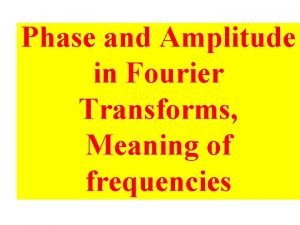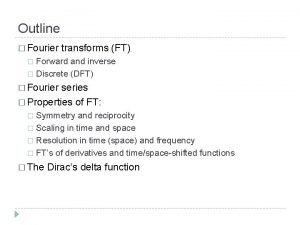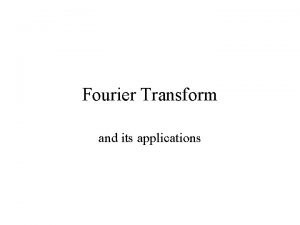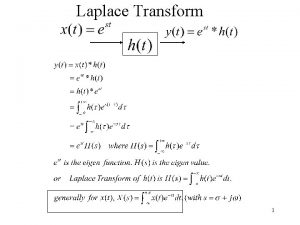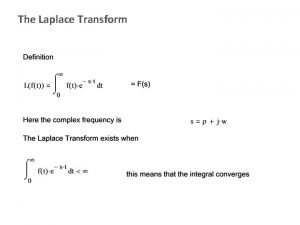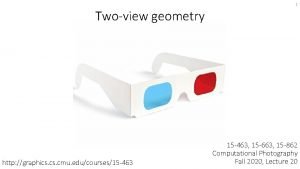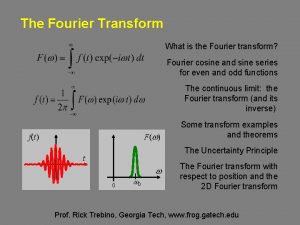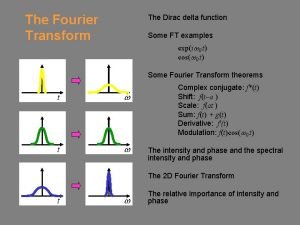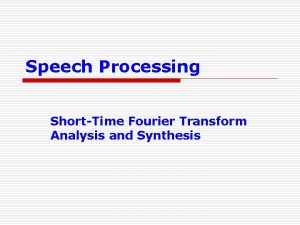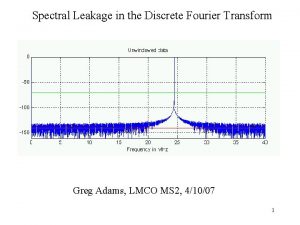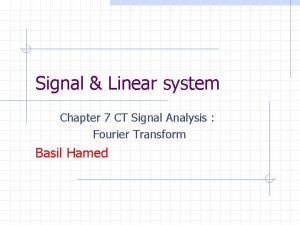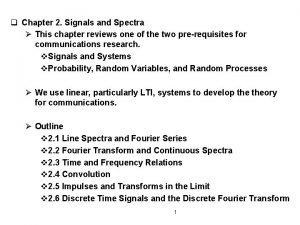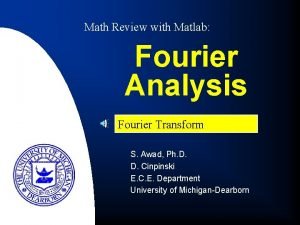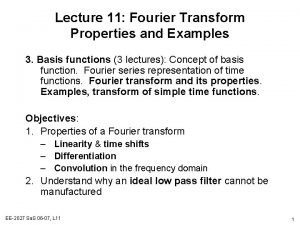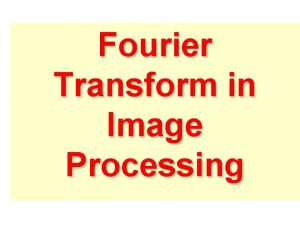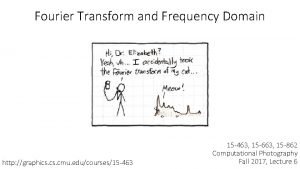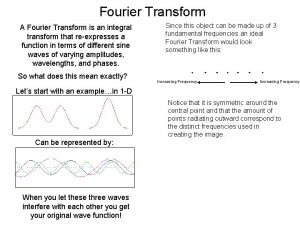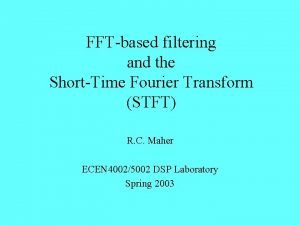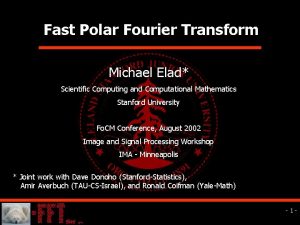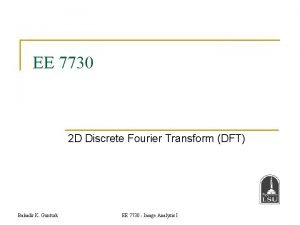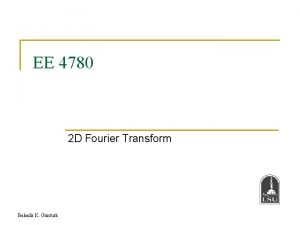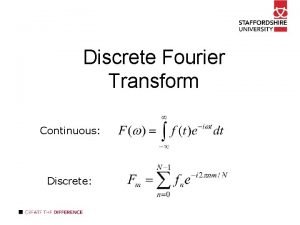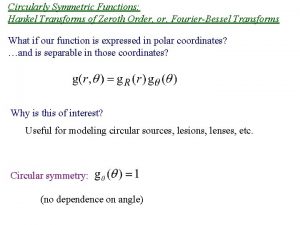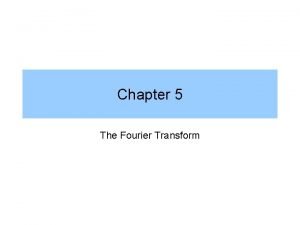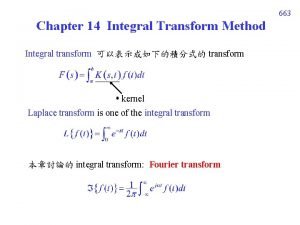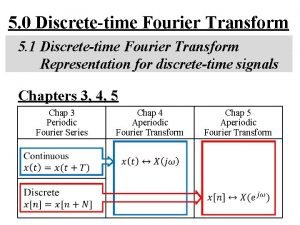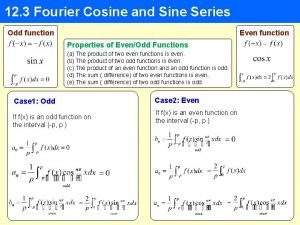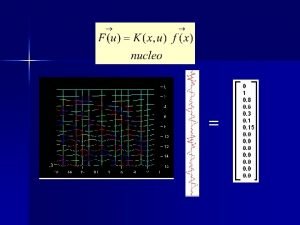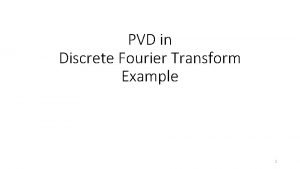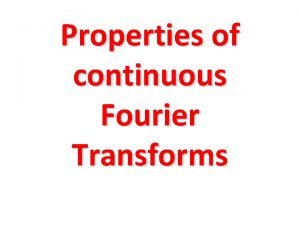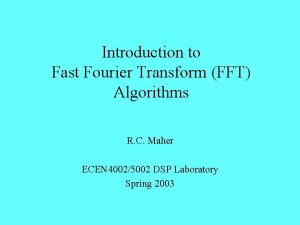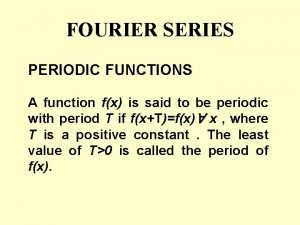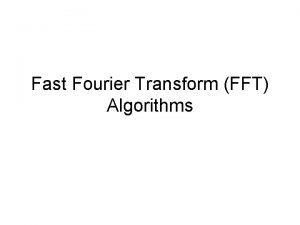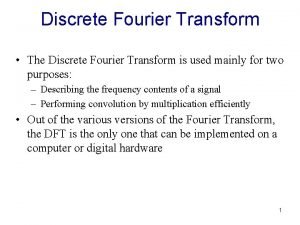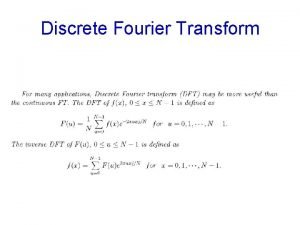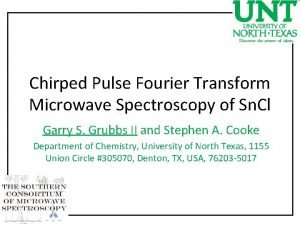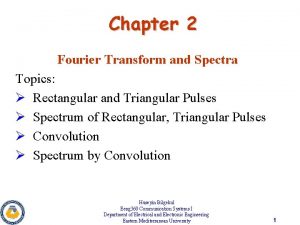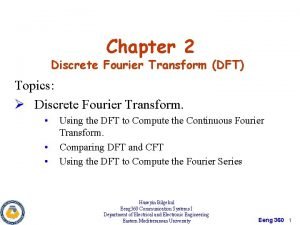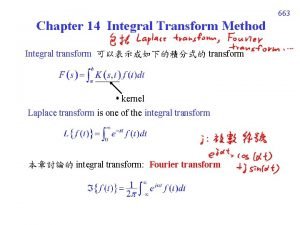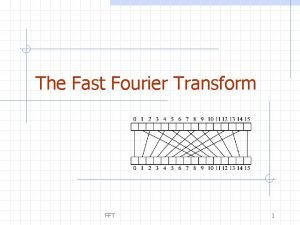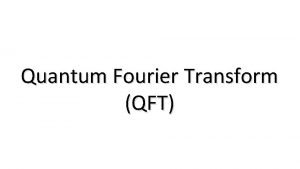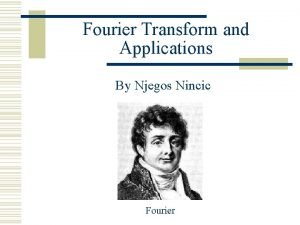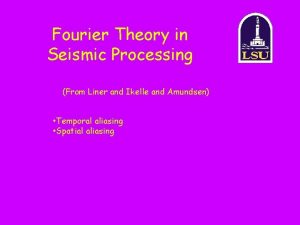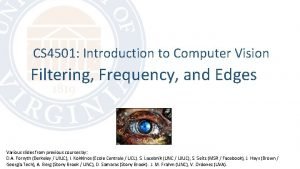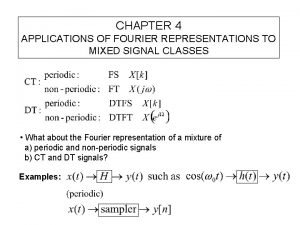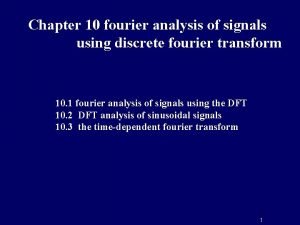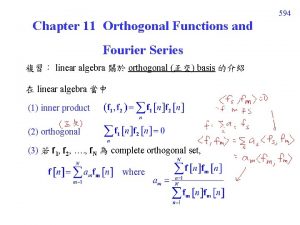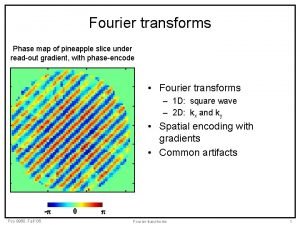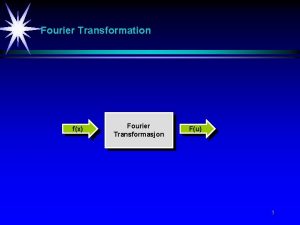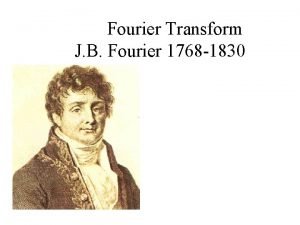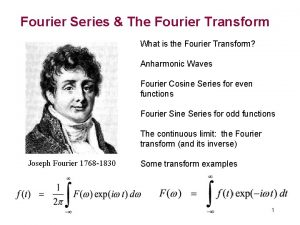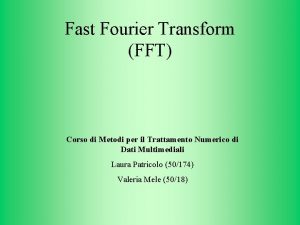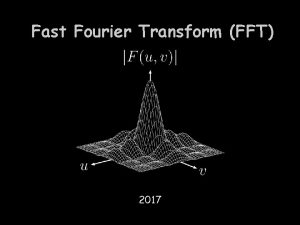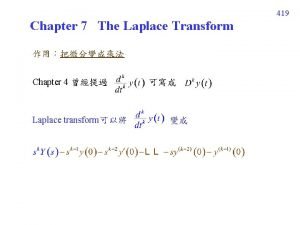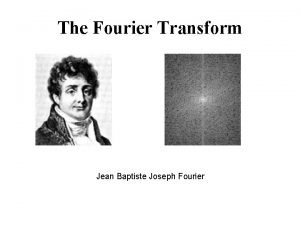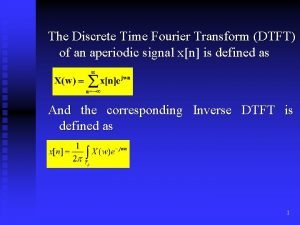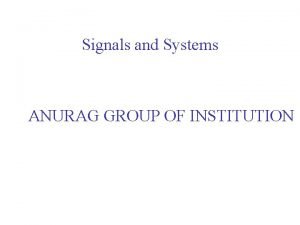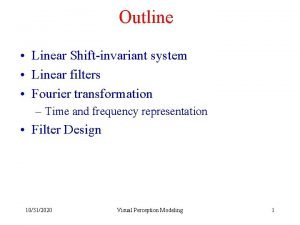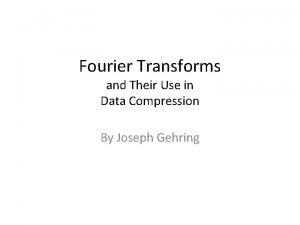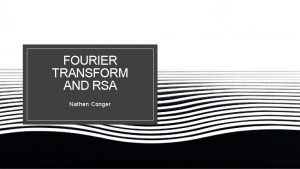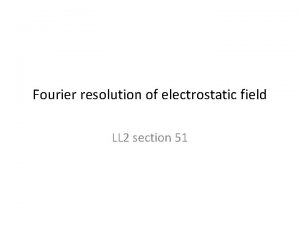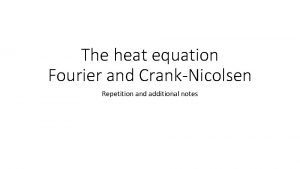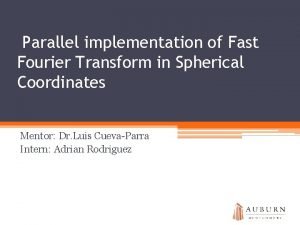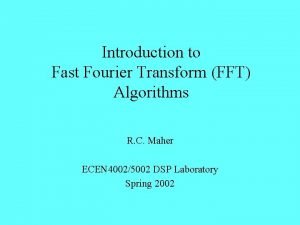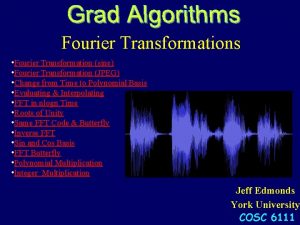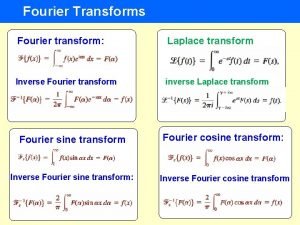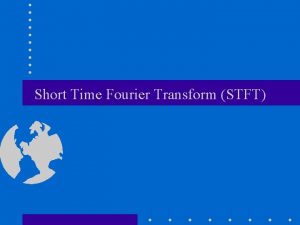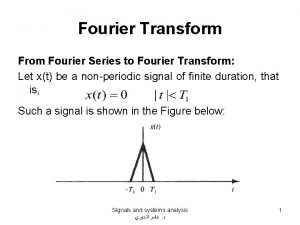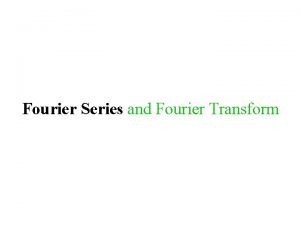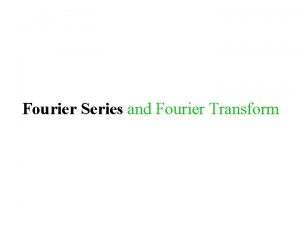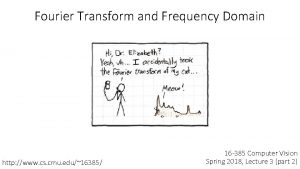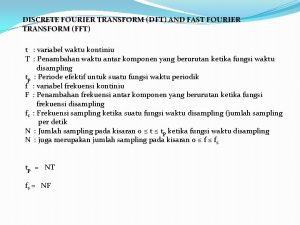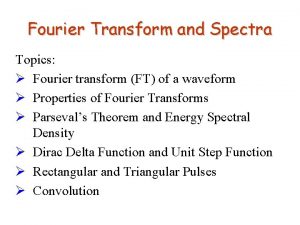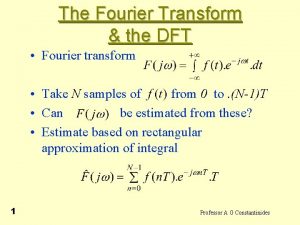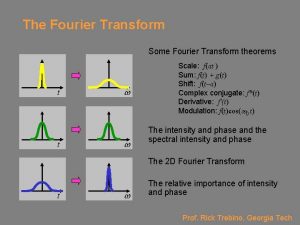Fourier Transform and Frequency Domain http graphics cmu
































































































- Slides: 96

Fourier Transform and Frequency Domain http: //graphics. cmu. edu/courses/15 -463, 15 -663, 15 -862 Computational Photography Fall 2017, Lecture 6

Course announcements • Last call for responses to Doodle about rescheduling the September 27 th lecture! - Link available on Piazza. - Currently 17 responses. I’ll pick a date on Tuesday evening. • Homework 1 is being graded. - Grades with comments will be uploaded on Canvas hopefully by Wednesday. - How was it? • Homework 2 has been posted. - Much larger than homework 1. - Start early! Experiments take a long time to run. - How many have read/started/finished it?

Overview of today’s lecture • Some history. • Fourier series. • Frequency domain. • Fourier transform. • Frequency-domain filtering. • Revisiting sampling.

Slide credits Most of these slides were adapted from: • Kris Kitani (15 -463, Fall 2016). Some slides were inspired or taken from: • Fredo Durand (MIT). • James Hays (Georgia Tech).

Some history

Who is this guy?

What is he famous for? Jean Baptiste Joseph Fourier (1768 -1830)

What is he famous for? The Fourier series claim (1807): ‘Any univariate function can be rewritten as a weighted sum of sines and cosines of different frequencies. ’ Jean Baptiste Joseph Fourier (1768 -1830)

What is he famous for? The Fourier series claim (1807): ‘Any univariate function can be rewritten as a weighted sum of sines and cosines of different frequencies. ’ … and apparently also for the discovery of the greenhouse effect Jean Baptiste Joseph Fourier (1768 -1830)

Is this claim true? The Fourier series claim (1807): ‘Any univariate function can be rewritten as a weighted sum of sines and cosines of different frequencies. ’ Jean Baptiste Joseph Fourier (1768 -1830)

Is this claim true? The Fourier series claim (1807): ‘Any univariate function can be rewritten as a weighted sum of sines and cosines of different frequencies. ’ Well, almost. • The theorem requires additional conditions. • Close enough to be named after him. • Very surprising result at the time. Jean Baptiste Joseph Fourier (1768 -1830)

Is this claim true? The Fourier series claim (1807): ‘Any univariate function can be rewritten as a weighted sum of sines and cosines of different frequencies. ’ Well, almost. • The theorem requires additional conditions. • Close enough to be named after him. • Very surprising result at the time. Jean Baptiste Joseph Fourier (1768 -1830) Malus Lagrange Legendre Laplace The committee examining his paper had expressed skepticism, in part due to not so rigorous proofs

Amusing aside Only known portrait of Adrien-Marie Legendre 1820 watercolor caricatures of French mathematicians Adrien. Marie Legendre (left) and Joseph Fourier (right) by French artist Julien-Leopold Boilly For two hundred years, people were misidentifying this portrait as him Louis Legendre (same last name, different person)

Fourier series

Basic building block Fourier’s claim: Add enough of these to get any periodic signal you want!

Basic building block amplitude sinusoid variable phase angular frequency Fourier’s claim: Add enough of these to get any periodic signal you want!

Examples How would you generate this function? = ? + ?

Examples How would you generate this function? = ? + ?

Examples How would you generate this function? = ? + ?

Examples How would you generate this function? = square wave ? + ?

Examples How would you generate this function? ≈ square wave = ? + ?

Examples How would you generate this function? ≈ square wave = ? + ?

Examples How would you generate this function? ≈ square wave = ? + ?

Examples How would you generate this function? ≈ square wave = ? + ?

Examples How would you generate this function? ≈ ? + ? square wave = How would you express this mathematically?

Examples = square wave infinite sum of sine waves How would could you visualize this in the frequency domain?

Examples = square wave infinite sum of sine waves magnitude frequency

Frequency domain

Visualizing the frequency spectrum amplitude frequency

Visualizing the frequency spectrum Recall the temporal domain visualization amplitude = frequency +

Visualizing the frequency spectrum Recall the temporal domain visualization amplitude = How do we plot. . . frequency +

Visualizing the frequency spectrum Recall the temporal domain visualization amplitude = frequency +

Visualizing the frequency spectrum Recall the temporal domain visualization amplitude = frequency +

Visualizing the frequency spectrum Recall the temporal domain visualization amplitude = + not visualizing the symmetric negative part frequency What is at zero frequency? Need to understand this to understand the 2 D version!

Visualizing the frequency spectrum Recall the temporal domain visualization amplitude = + not visualizing the symmetric negative part frequency signal average (zero for a sine wave with no offset) Need to understand this to understand the 2 D version!

Examples Spatial domain visualization Frequency domain visualization 1 D 2 D ?

Examples Spatial domain visualization Frequency domain visualization 1 D 2 D What do the three dots correspond to?

Examples Spatial domain visualization Frequency domain visualization ?

Examples Spatial domain visualization Frequency domain visualization

Examples How would you generate this image with sine waves?

Examples How would you generate this image with sine waves? Has both an x and y components

Examples + = ?

Examples + = ?

Examples + =

Basic building block amplitude sinusoid variable angular frequency phase What about nonperiodic signals? Fourier’s claim: Add enough of these to get any periodic signal you want!

Fourier transform

Recalling some basics Complex numbers have two parts: rectangular coordinates what‘s this?

Recalling some basics Complex numbers have two parts: rectangular coordinates real imaginary

Recalling some basics Complex numbers have two parts: rectangular coordinates real imaginary Alternative reparameterization: polar coordinates how do we compute these? polar transform

Recalling some basics Complex numbers have two parts: rectangular coordinates real imaginary Alternative reparameterization: polar coordinates polar transform

Recalling some basics Complex numbers have two parts: rectangular coordinates real imaginary Alternative reparameterization: polar coordinates polar transform How do you write these in exponential form?

Recalling some basics Complex numbers have two parts: rectangular coordinates real imaginary Alternative reparameterization: polar coordinates polar transform or equivalently how did we get this? exponential form

Recalling some basics Complex numbers have two parts: rectangular coordinates real imaginary Alternative reparameterization: polar coordinates polar transform or equivalently Euler’s formula exponential form This will help us understand the Fourier transform equations

Fourier transform inverse Fourier transform discrete continuous Fourier transform Where is the connection to the ‘summation of sine waves’ idea?

Fourier transform inverse Fourier transform discrete continuous Fourier transform Where is the connection to the ‘summation of sine waves’ idea?

Fourier transform Where is the connection to the ‘summation of sine waves’ idea? Euler’s formula sum over frequencies scaling parameter wave components

Fourier transform pairs spatial domain Note the symmetry: duality property of Fourier transform frequency domain

Computing the discrete Fourier transform (DFT)

Computing the discrete Fourier transform (DFT) is just a matrix multiplication: In practice this is implemented using the fast Fourier transform (FFT) algorithm.

Another way to compute the Fourier transform Use a lens! An ideal thin lens is an optical Fourier transform engine.

Fourier transforms of natural images original amplitude phase

Fourier transforms of natural images Image phase matters! cheetah phase with zebra amplitude zebra phase with cheetah amplitude

Frequency-domain filtering

Why do we care about all this?

The convolution theorem The Fourier transform of the convolution of two functions is the product of their Fourier transforms: The inverse Fourier transform of the product of two Fourier transforms is the convolution of the two inverse Fourier transforms: Convolution in spatial domain is equivalent to multiplication in frequency domain!

What do we use convolution for?

Convolution for 1 D continuous signals Definition of linear shift-invariant filtering as convolution: filtered signal filter input signal Using the convolution theorem, we can interpret and implement all types of linear shift-invariant filtering as multiplication in frequency domain. Why implement convolution in frequency domain?

Frequency-domain filtering in Matlab Filtering with fft: im = double(imread(‘…'))/255; im = rgb 2 gray(im); % “im” should be a gray-scale floating point image [imh, imw] = size(im); hs = 50; % filter half-size fil = fspecial('gaussian', hs*2+1, 10); fftsize = 1024; % should be order of 2 (for speed) and include im_fft = fft 2(im, fftsize); % 1) padding fil_fft = fft 2(fil, fftsize); % 2) same size as image im_fil_fft = im_fft. * fil_fft; % 3) images im_fil = ifft 2(im_fil_fft); % 4) im_fil = im_fil(1+hs: size(im, 1)+hs, 1+hs: size(im, 2)+hs); % 5) padding fft im with fft fil, pad to multiply fft inverse fft 2 remove padding Displaying with fft: figure(1), imagesc(log(abs(fftshift(im_fft)))), axis image, colormap jet

Spatial domain filtering filter kernel = Fourier transform inverse Fourier transform = Frequency domain filtering

Revisiting blurring Why does the Gaussian give a nice smooth image, but the square filter give edgy artifacts? Gaussian filter Box filter

Gaussian blur

Box blur

A lens’ kernel is its aperture This is (one of the reasons) why we try to make lens apertures as circular as possible. circular aperture (Airy disk) An ideal thin lens is an optical Fourier transform engine. rectangular aperture

More filtering examples ? filters shown in frequencydomain ?

More filtering examples low-pass band-pass filters shown in frequencydomain

More filtering examples high-pass ?

More filtering examples high-pass

More filtering examples original image low-pass filter ? frequency magnitude

More filtering examples original image frequency magnitude low-pass filter

More filtering examples original image high-pass filter ? frequency magnitude

More filtering examples original image frequency magnitude high-pass filter

More filtering examples original image frequency magnitude band-pass filter

More filtering examples original image frequency magnitude band-pass filter

More filtering examples original image frequency magnitude band-pass filter

More filtering examples original image frequency magnitude band-pass filter

Revisiting sampling

The Nyquist-Shannon sampling theorem A continuous signal can be perfectly reconstructed from its discrete version if sampling occurred with frequency: This is called the Nyquist frequency Equivalent reformulation: When downsampling, aliasing does not occur if samples are taken at the Nyquist frequency or higher.

The Nyquist-Shannon sampling theorem A continuous signal can be perfectly reconstructed from its discrete version if sampling occurred with frequency: This is called the Nyquist frequency

Gaussian pyramid How does the Nyquist-Shannon theorem relate to the Gaussian pyramid?

Gaussian pyramid How does the Nyquist-Shannon theorem relate to the Gaussian pyramid? • Gaussian blurring is low-pass filtering. • By blurring we try to sufficiently decrease the Nyquist frequency to avoid aliasing. How large should the Gauss blur we use be?

Frequency-domain filtering in human vision Gala Contemplating the Mediterranean Sea Which at Twenty Meters Becomes the Portrait of Abraham Lincoln (Homage to Rothko) Salvador Dali, 1976

Frequency-domain filtering in human vision Low-pass filtered version

Frequency-domain filtering in human vision High-pass filtered version

Variable frequency sensitivity contrast Experiment: Where do you see the stripes? frequency

Variable frequency sensitivity contrast Campbell-Robson contrast sensitivity curve Our eyes are sensitive to mid-range frequencies frequency • Early processing in humans filters for various orientations and scales of frequency • Perceptual cues in the mid frequencies dominate perception

References Basic reading: • Szeliski textbook, Sections 3. 4. Additional reading: • Goodman, “Introduction to Fourier Optics, ” W. H. Freeman Publishing 2004. the standard reference on Fourier optics • Hubel and Wiesel, “Receptive fields, binocular interaction and functional architecture in the cat's visual cortex, ” The Journal of Physiology 1962 a foundational paper describing information processing in the visual system, including the different types of filtering it performs; Hubel and Wiesel won the Nobel Prize in Medicine in 1981 for the discoveries described in this paper
 Multiplication property of fourier transform
Multiplication property of fourier transform Fourier transformation properties
Fourier transformation properties Frquency domain
Frquency domain Z domain to frequency domain
Z domain to frequency domain Time reversal z transform
Time reversal z transform The z transform of np
The z transform of np Phase invariance
Phase invariance Inverse discrete fourier transform
Inverse discrete fourier transform The fourier transform and its applications
The fourier transform and its applications Relation between laplace and fourier transform
Relation between laplace and fourier transform Laplace of t
Laplace of t Computer graphics cmu
Computer graphics cmu Sinc to rect
Sinc to rect Fourier transform delta function
Fourier transform delta function Ct ft
Ct ft Short time fft
Short time fft Dft table
Dft table Parseval's identity for fourier transform
Parseval's identity for fourier transform Rect(t-1/2)
Rect(t-1/2) Line spectrum in signals and systems
Line spectrum in signals and systems Matlab ramp function
Matlab ramp function Fourier transform mri
Fourier transform mri Fourier transform of x
Fourier transform of x Fourier series of unit step function
Fourier series of unit step function Fourier transform of a gaussian
Fourier transform of a gaussian Fourier transform of 1
Fourier transform of 1 Properties of fourier transform in digital image processing
Properties of fourier transform in digital image processing Fourier transform formula
Fourier transform formula Fourier transform of an integral
Fourier transform of an integral Short time fourier transform
Short time fourier transform Fourier transform in polar coordinates
Fourier transform in polar coordinates Fourier transform of product of two functions
Fourier transform of product of two functions 2d discrete fourier transform
2d discrete fourier transform Sinc fourier transform
Sinc fourier transform Fourier series of impulse train
Fourier series of impulse train Discrete fourier transform
Discrete fourier transform Overlap save method
Overlap save method Circ function fourier transform
Circ function fourier transform Fourier transform duality examples
Fourier transform duality examples Fourier transform definition
Fourier transform definition Fourier transform of multiplication of two signals
Fourier transform of multiplication of two signals Fourier transform
Fourier transform Fourier transform table
Fourier transform table Fourier integral representation
Fourier integral representation Duality of fourier transform
Duality of fourier transform Site:slidetodoc.com
Site:slidetodoc.com Windowed fourier transform
Windowed fourier transform Fourier transform
Fourier transform Fourier transform notation
Fourier transform notation R fft
R fft Fourier transform solver
Fourier transform solver Fourier transform of a periodic function
Fourier transform of a periodic function Dft vs fft
Dft vs fft Discrete fourier transform formula
Discrete fourier transform formula Application of discrete fourier transform
Application of discrete fourier transform Chirped pulse fourier transform microwave spectroscopy
Chirped pulse fourier transform microwave spectroscopy Fourier transform of shifted rectangular pulse
Fourier transform of shifted rectangular pulse Discrete fourier transform formula
Discrete fourier transform formula Sine integral
Sine integral Fft integer multiplication
Fft integer multiplication Top hat function fourier transform
Top hat function fourier transform Inverse of fourier transform
Inverse of fourier transform Fractional fourier transform
Fractional fourier transform Fourier transformation definition
Fourier transformation definition Application of discrete fourier transform
Application of discrete fourier transform Fourier transform seismic
Fourier transform seismic Inverse of fourier transform
Inverse of fourier transform Fourier transform computer vision
Fourier transform computer vision Fourier transform complex analysis
Fourier transform complex analysis Inverse dtfs
Inverse dtfs Nstemk
Nstemk Orthogonal functions and fourier series
Orthogonal functions and fourier series Fourier transform
Fourier transform Fourier transform
Fourier transform Fourier transform
Fourier transform Fourier transform in image processing
Fourier transform in image processing Fourier series
Fourier series Fast fourier transform (fft)
Fast fourier transform (fft) Fast fourier transform
Fast fourier transform Fourier transform of impulse signal
Fourier transform of impulse signal Even fourier
Even fourier Dirac delta function fourier transform
Dirac delta function fourier transform Fourier cosine transform of f(x)=1
Fourier cosine transform of f(x)=1 Dtft symmetry property
Dtft symmetry property Image processing and analysis stan birchfield pdf
Image processing and analysis stan birchfield pdf Sinc wave
Sinc wave Parseval's identity
Parseval's identity Classification of signals
Classification of signals Ehler fisher transform strategy
Ehler fisher transform strategy Sinc function fourier transform
Sinc function fourier transform Jpeg fourier transform
Jpeg fourier transform Desmos convolution
Desmos convolution Fourier transform formula
Fourier transform formula Heat equation
Heat equation Fourier transform spherical coordinates
Fourier transform spherical coordinates Fft
Fft Jpeg fft
Jpeg fft






